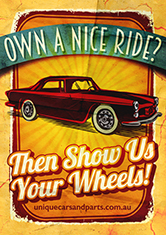
We hope to bring you new and interesting content on our YouTube channel. Please support us by subscribing.



The Willys Overland Transmission and SuspensionThe transmission was operated by 8.5 in. diameter single-plate clutch of the dry type, with a sealed grease packed ball release bearing with a torque rating of 147 lb./ft. The rear axle was of the semi-floating hypoid gear type featuring underslung spring seats with a ratio of 4.56 to 1. The suspension in the front was by coil springs of unusual design; the layout being suited to the overall unit-body-chassis structure. There were two wishbones at each side, and the coil spring was carried between the upper wishbone and the inside of the wheel arc, thus spreading suspension loads into the scuttle and avoiding the need for heavy front cross members. With this system, Willys caimed that anti-roll bars were unnecessary. The rear suspension was by half elliptic and there were direct acting shock absorbers all round. All front suspension joints, including the king pin pivots have threaded bushies. Behind the WheelThe brakes on the Willys Overland were of the hydraulic external expanding, two shoe floating anchor, self-centring type operating on all four wheel:. The general layout of the car was handsome and practical. Both front wings were visible through the two-piece curved glass windscreen. Seated in the driving position the bonnet slopes away, giving an excellent view of the immediate road ahead. The rear view is excellent through the 53.5 in. long rear window. In general construction, the body was in the one unit featuring the chassis framing built in as a part of the body structure. Two box-shaped frame members along the sides, running from front to rear, constituted the major framing members. Inside there was excellent comfort for six passengers, the seat width front and rear being 61 in. The external appearance of the car is very clean and the minimum of chrome ornaments weighing down the front end was a change from then current American practice. The overdrive fitted to the Willys helped to return a good fuel consumption of about 28 m.p.g., and when you considered that at a constant 80 m.p.h. the car would return 18 m.p.g. it proved excellent from the economy angle. In acceleration 0-50 m.p.h. could be attained through the gears in 11 seconds and a top speed of about 90 m.p.h. was claimed by the manufacturers. Although Jeep production was steady, sales of the Willys and Kaiser cars continued to fall. Willys established an assembly plant in Brazil in 1953, after the government prohibited the import of assembled vehicles as part of an import substitution program. In 1954, the CJ5 debuted at the start of its three-decade run. After the last Willys passenger car was built in 1955, Willys shipped the Aero's tooling to Brazil, where it was built from 1960 to 1962, almost unchanged. Brooks Stevens restyled the Aero for 1963, and it was built by Ford(which bought the Willys factory) until the 1970s. In America, the company changed its name in 1963 to Kaiser-Jeep Corporation; the Willys name disappeared thereafter. 
|
Reader Reviews page 0 of 0
There are currently 0 reviews to display.
Add Your Review
<>
|
|||||||||||||||||||||||||||||||||||||||||||